上海牛津英语5A全部教案设计
牛津小学英语5a教案

牛津小学英语5A教案一、教学目标1.能够听、说、读、写并理解牛津小学英语5A教材中的单词和句子。
2.能够正确运用所学知识进行简单的对话和交流。
3.培养学生的听、说、读、写和思维能力,提高他们的英语综合应用能力。
二、教学内容Unit 1: My school•熟悉学校的英文表达,如:classroom, library, playground, etc。
•学习与学校相关的字母拼读和单词,如:A, B, C, school, book, pen, etc。
•学习日常用语,如:What’s this? It’s a book. Thank you. No problem, etc。
Unit 2: My family•学习家庭成员的称呼和表述,如:father, mother, brother, sister, etc。
•学习描述家庭成员特征的形容词,如:big, small, tall, short, etc。
•学习用英语对家庭成员进行简单介绍。
Unit 3: At the zoo•学习动物的英文表达,如:elephant, lion, monkey, etc。
•学习描述动物特征的形容词,如:big, small, long, short, etc。
•学习用英语描述动物的行为和习性。
三、教学步骤Unit 1: My school1.引入学校的英文表达:展示图片,引导学生说出学校中的不同场所和事物的英文名称。
– e.g. Classroom– e.g. Library– e.g. Playground2.讲解字母拼读和单词:通过图片和卡片的方式,教授与学校相关的字母拼读和单词。
– e.g. A - apple– e.g. B - book– e.g. C - classroom3.进行简单对话练习:使用所学的单词和句子进行简单的对话练习,鼓励学生互相交流和问答。
–A: What’s this?–B: It’s a book.–A: Thank you.–B: No problem.Unit 2: My family1.引入家庭成员的称呼和表述:展示图片,引导学生说出不同家庭成员的英文称呼和描述。
牛津上海版小学五年级上册5A教案[全册].docx
![牛津上海版小学五年级上册5A教案[全册].docx](https://img.taocdn.com/s3/m/b944c51ed5bbfd0a7856735a.png)
5AM1U1 My b让thday 单元设计()>单元任务分析该单元的主题为My birthday,要求学生掌握的核心词汇是序数词:first、second> thirds fourth、fifth> sixth等,让学生会用序数词正确表达日期,如:the fourth of October«还可根据学生的具体情况拓展序数词的使用。
主要句型是When' s…birthday?及冋答It' s on the-of-o要求学生能以我的生日为主题,进行时间、内容、地点等的问答,邀请函的设计等。
除了核心词Z外,本单元还需要复习再现有关月份、星期、时间等的表达。
另外,需要常握和操练的词汇和词组包括bring some orange things to the party> make a birthday invitation、make hats等,这些词组在日常交流中实际使用价值较大,可结合学生的实际情况进行教学,使学生可以做到运用这些词汇进行流利地交流。
音标教学方面,对[i:][l]进行发音的归类,让学生能看到音标想到字母或字母组合。
在情感表达方而,生日主题侧重通过邀请卡的书写,生日相关时间、地点、主题的问答,生日聚会的开展营造生日前和生日屮的愉快氛围。
本单元的故事教学是生日主题的延续,通过讲述父亲的辛苦工作及生日时收到父亲亲手制作的礼物的兴奋,旨在SZ习巩固新旧知识的同时,教育孩子懂得感恩。
>单元教学目标通过本单元的学习,学生能:1.掌握序数词:first、second^ third、fourth> fifth> sixth .........................掌握单词:patty、begin、bring> wcar> favourite2.掌握句型:When' s …birthday? It' s on the・・・of…The sounds interesting. I can' t wait.3.复习巩固月份、星期、服饰的单词和词组及时间表达法。
上海版牛津英语5a教案全册
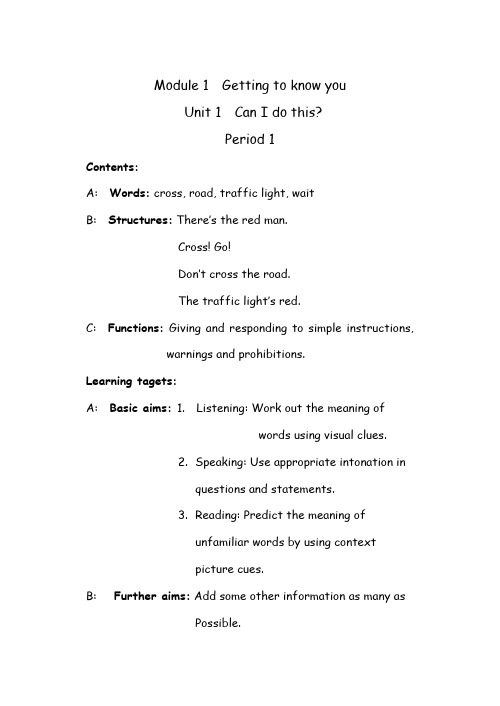
Module 1 Getting to know youUnit 1 Can I do this?Period 1Contents:A: Words: cross, road, traffic light, waitB: Structures: There’s the red man.Cross! Go!Don’t cross the road.The traffic light’s red.C: Functions:Giving and responding to simple instructions, warnings and prohibitions.Learning tagets:A: Basic aims: 1. Listening: Work out the meaning ofwords using visual clues.2.Speaking: Use appropriate intonation inquestions and statements.3.Reading: Predict the meaning ofunfamiliar words by using contextpicture cues.B: Further aims: Add some other information as many asPossible.Language focus:1. Using the introductory ‘there’ to express facts.2. Using imperatives to give instructions.3. Using imperatives to express prohibitions.4. Using nouns to identify objects.Materials and aids: Student’s Book 5A page 2Cassette 5A and a cassette playerWorkbook 5A page 1Word and Picture Cards 5AUnit position: In Grade Four, students have learned thesentences: There be… Don’t… In this period,they will continue to practice these sentences.They can use the introductory ‘there’ toexpress facts. They can use imperatives toexpress prohibitions and give instructions.They can use nouns to identify objects.Period 2Contents:A: Words: go out, outB: Structures: Can I go out, Mum?Here you are.C: Functions: Asking for and giving/denying permission to do simple things.Learning tagets:A: Basic aims: 1. Listening: Recognize differences in the useof intonation to differentiatebetween questions andstatements.2. Speaking: Use appropriate intonation inquestions and statements.3. Reading: Predict story using picture cues.4. Writing: Develop written texts by addinginformation to writing when amodel or framework is provided. B: Further aims: Add some other information as many aspossibleLanguage focus:1. Using modals to ask for permission.2. Using formulaic expressions to reply to requests. Materials and aids: Student’s Book 5A page 3Cassette 5A and a cassette playerWorkbook 5A page 1Unit position: In Grade Four, students have learned thesentences: Can you…? In this period, they willuse modals to ask for permission. They can useformulaic expressions to replay to requests.Period 3Contents:A: Words: drink, mean, or, one, sign, smoke, station,underground, wait for, way, whichB: Structures: Go out this way.Don’t smoke.They are going out.They are on the train.Which sign means…?C: Functions: Asking about and recognizing common signs in English.Learning tagets:A: Basic aims: 1. Speaking: Use modeled phrases andsentences to communicatewith teachers and otherlearners.2.Reading: Locate specific information in ashort text in response toquestions. Identify main ideasfrom a text with teachersupport.3.Writing: Gather and share information,ideas and language by usingstrategies such as observing. B: Further aims: Add some other information as many aspossible.Language focus:1. Using imperatives to give instructions.2. Using imperatives to express prohibitions.3. Using the present continuous tense to describe an action taking place at the time of speaking.4. Using the present continuous tense to express simple truths.5. Using ‘Wh-’ questions to find out various kinds of specific information about an object.Materials and aids: Student’s Book 5A page 4Cassette 5A and a cassette playerWorkbook 5A page 2Word and Picture Cards 5AUnit position: In Grade Four, students have learned thepresent continuous tense. In this period, theywill continue to practice the present continuoustense. They can use the present continuous tense to describe an action taking place at the time of speaking and express simple truths.Period 4Contents:A: Words: make a noise, rubbishB: Structures: Don’t make a noise.I’m sorry, Miss Fang.C: Functions: Asking about and recognizing common signs inEnglish.Learning tagets:A: Basic aims: Speaking: Use appropriate intonation instatements.B: Further aims: Add some other information as many aspossibleLanguage focus:1. Using imperatives to express prohibitions.2. Using formulaic expressions to express apologies. Materials and aids: Student’s Book 5A page 5Cassette 5A and a cassette playerDrawing paperUnit position: In Grade Four, students have learned somesigns. In this period, they will continue to readand write some signs. They can useimperatives to express prohibitions. They can use formulaic expressions to express apologies.Unit 2 This is what I wantPeriod 1Contents:A: Words: glue, paper, scissors, tape, wantB: Structures: What do you want, Alice?I want some paper, please.Here’s some paper.Thank you very much.C: Functions: Asking about and expressing wants. Learning tagets:A: Basic aims: 1. Speaking: Use modeled phrases andsentences to communicatewith teachers and otherlearners. Use appropriateintonation in questions andstatements.2.Writing: Develop written texts byputting words in a logical orderto make meaningful phrasesor sentences.B: Further aims: Add some other information as many aspossibleLanguage focus:1. Asking ‘Wh-‘ questions to find out specific information.2. Using the simple present to make request.3. Using formulaic expressions to replay to requests.4. Using formulaic expressions to express thanks. Materials and aids: Student’s Book 5A page 6Cassette 5A and a cassette playerWorkbook 5A page 3Word and Picture Cards 5AUnit position: In Grade Four, students have learned thesentences: I want… Here’s…Here are… Thankyou very much. In this period, they willcontinue to practice these sentences. Theywill study how to ask ‘Wh-‘ questions to findout specific information. They can use thesimple present to make request. They can useformulaic expressions to replay to requests.They can use formulaic expressions to expressthanks.Period 2Contents:A: Words: BigMac, French fries, McChicken, a large Coke B: Structures: What do you want?I want a McChicken and some orange juice,please.C: Functions: Asking about and expressing wants. Learning tagets:A: Basic aims: 1. Listening: Locate specific information inresponse to simple instructionsor questions.2. Speaking: Open an interaction inresponse. Maintain aninteraction by providinginformation to questions. B: Further aims: Add some other information as many aspossible.Language focus:1. Asking ‘Wh-‘ questions to find out specific information.ing the simple present tense to make requests.ing attributive adjectives to describe objects.Materials and aids: Student’s Book 5A page 7Cassette 5A and a cassette playerWorkbook 5A page 4Unit position: In Grade Four, students have learned somekind of food. In this period, they will learnsome new words about food. They will ask‘Wh-‘ questions to find out specificinformation. They can use the simple presenttense to make requests. They can useattributive adjectives to describe objects.Period 3Contents:A: Words: picnicB: Structures: I’m hungry./I’ve got some …What have we got?C: Functions: Comprehension a simple narrative. Learning tagets:A: Basic aims: 1. Listening: Locate specific information inresponse to simple instructionsor questions.2. Speaking: Open an interaction byeliciting a response. Maintainan interaction by providinginformation in response toquestions.3.Reading: Recognize a familiar words inunfamiliar contexts.B: Further aims: Add some other information as many aspossible.Language focus:1. Using the simple present tense to express simple truths.2. Asking ‘Wh-‘ questions to find out specific information. Materials and aids: Student’s Book 5A page 8Cassette 5A and a cassette playerPictures of food cut out frommagazinesDrawing paperWallpictures 5AUnit position: In Grade Four, students have learned thesentences: I’m hungry. I want some… In thisperiod, they will continue to practice thesesentences. They will study how to ask‘Wh-‘ questions to find out specific information.They can use the simple present tense toexpress simple truths.Period 4Contents:A: Words: vegetable, noodlesB: Structures: What do you want?Can I have some fish, please?There you are.C: Functions: Asking about and expressing wants.Expressing thanks.Learning tagets:A: Basic aims: 1. Listening: Identify main ideas.Locate specific information inresponse to simple instructionsor questions.2. Speaking: Produce simple phrases andsentences involving repetition.Open an interaction by elicitinga response.Close an interaction by usingappropriate formulaic phrases.3. Reading: Predict story, characters usingpicture cues. Locate specificinformation in a short text.Identify main ideas from a textwith teacher support.4.Writing: Develop written text by addinginformation to writing.B: Further aims: Add some other information as many aspossible.Language focus:1. Using ‘Wh-‘ questions to find out specific information.ing modals to make requests.ing formulaic expressions to reply to requests.ing nouns to identify objects.Materials and aids: Student’s Book 5A page 9Cassette 5A and a cassette playerWord and Picture Cards 5AWorkbook 5A page 4Food packetsUnit position: Students have learned the sentences in thefirst, second and third period. In this period,they will continue to practise these sentences.They will use ‘Wh-‘ questions to find outspecific information. They can use modals to make requests. They can use formulaic expressions to reply to requests and use nouns to identify objects.Unit 3 This is what I needPeriod 1Contents:A: Words: for, need, uniform, socksB: Structures: Kitty, what do you need for school?C: Functions: Comprehending a simple narrative. Learning tagets:A: Basic aims: 1. Listening: Recognize differences in the useof intonation to differentiatebetween questions andstatements. Locate specificinformation in response toquestions.2. Speaking: Produce simple sentencesinvolving repetition or lists.Use modeled phrases andsentences to communicate withteachers and other learners.3. Writing: Develop written text by addingpersonal ideas and informationto writing when a modal orframework is provided.B: Further aims: Add some other information as many aspossible.Language focus:1. Using nouns to identify objects.2.Asking ‘Wh-‘ questions to find out various kinds of specificinformation about a person.ing indefinite determiners to refer to an unspecifiednumber of things.ing attributive adjectives to describe objects. Materials and aids: Student’s Book 5A page 9Cassette 5A and a cassette playerWord and Picture Cards 5AUnit position: Students have learned the phrases: somebooks, some crayons… in Grade Four. In thisperiod, they will continue to use indefinitedeterminers to refer an unspecified numberof things. They can use nouns to identifyobjects and use attributive adjectives todescribe objects. They can ask ‘Wh-‘questions to find out various kinds of specificinformation about a person.。
上海全部整合版本牛津英语5A备课教案.docx
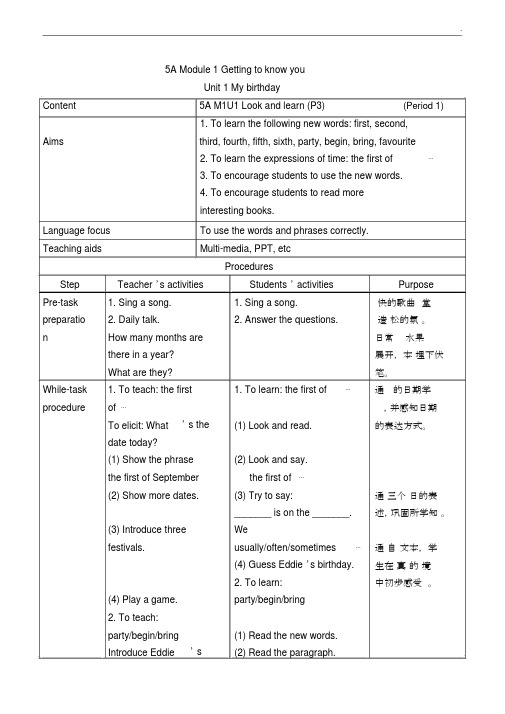
.5A Module 1 Getting to know youUnit 1 My birthdayContent5A M1U1 Look and learn (P3)(Period 1)1. To learn the following new words: first, second,Aims third, fourth, fifth, sixth, party, begin, bring, favourite2. To learn the expressions of time: the first of⋯3.To encourage students to use the new words.4.To encourage students to read moreinteresting books.Language focus To use the words and phrases correctly.Teaching aids Multi-media, PPT, etcProceduresStep Teacher ’s activities Students ’ activities PurposePre-task 1. Sing a song. 1. Sing a song.快的歌曲堂preparatio 2. Daily talk. 2. Answer the questions.造松的氛。
n How many months are日常水果there in a year?展开,本埋下伏What are they?笔。
While-task 1. To teach: the first 1. To learn: the first of⋯通的日期学procedure of ⋯,并感知日期To elicit: What’ s the(1)Look and read.的表达方式。
date today?(1) Show the phrase(2)Look and say.the first of September the first of ⋯(2) Show more dates.(3)Try to say:通三个日的表_______ is on the _______.述,巩固所学知。
牛津小学英语5A教案——Unit优秀3篇

牛津小学英语5A教案——Unit优秀3篇牛津小学英语5A教案——Unit 篇一unit 2 a new house第一教时一、教学内容5a 第二单元第一教时(read and say)二、教学目标1、能正确理解、掌握对话内容、并能朗读、初步表演对话。
2、能正确地听、说、读、写词汇a study、 a bedroom、a wall、a door、a bed3、能正确地听、说、读、词汇large、 beside、between、live4、能正确地听、说、读、句型what's in / on / under / beside / behind/between…? there's a /an… in /on/under/beside/behind/between…there aresome…in/on/under/beside/behind/between…there isn't a/an… there aren't any …三、教学重点:能正确理解、掌握对话内容、并能朗读、初步表演对话。
四、教学难点:能比较流畅地朗读对话并能在掌握对话内容的基础上进一步表演对话。
五、教学准备:1、教师准备校园、家庭平面图等。
2、录音机、磁带。
3、学生准备一张家庭平面图。
六、教学过程:a revision1. free talkglad to see you. it's the fifth day of the new term…2. 课件出示unit 1课文图片进行问答what's in your school? there is a building in my school.how many classrooms are there ? there are …is there a sports hall? yes / noare there any reading rooms in the building? yes, there are /no, there aren't .where're the computer rooms? they 're on the second floor.…b presentation and practice出示课件yang ling家的新居平面图进行问答1. 复习单词a bathroom, a bedroom, a study, a kitchen, a dining-room, a sitting-room.2. 借助图片,教师描述新居的情况。
牛津小学英语5a教案
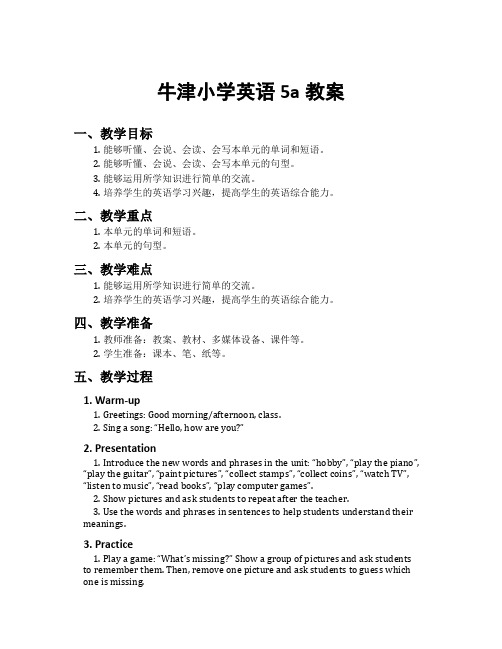
牛津小学英语5a教案一、教学目标1.能够听懂、会说、会读、会写本单元的单词和短语。
2.能够听懂、会说、会读、会写本单元的句型。
3.能够运用所学知识进行简单的交流。
4.培养学生的英语学习兴趣,提高学生的英语综合能力。
二、教学重点1.本单元的单词和短语。
2.本单元的句型。
三、教学难点1.能够运用所学知识进行简单的交流。
2.培养学生的英语学习兴趣,提高学生的英语综合能力。
四、教学准备1.教师准备:教案、教材、多媒体设备、课件等。
2.学生准备:课本、笔、纸等。
五、教学过程1. Warm-up1.Greetings: Good morning/afternoon, class.2.Sing a song: “Hello, how are you?”2. Presentation1.Introduce the new words and phrases in the unit: “hobby”, “play the piano”, “play the guitar”, “paint pictures”, “collect stamps”, “collect coins”, “watch TV”, “listen to music”, “read books”, “play computer games”.2.Show pictures and ask students to repeat after the teacher.e the words and phrases in sentences to help students understand their meanings.3. Practice1.Play a game: “What’s missing?” Show a group of pictures and ask students to remember them. Then, remove one picture and ask students to guess which one is missing.2.Ask students to work in pairs and talk about their hobbies using the new words and phrases they have learned.3.Have students read the dialogue in the textbook and practice it in pairs.4. Production1.Ask students to make a poster about their hobbies using the new words and phrases they have learned.2.Have students present their posters to the class and talk about their hobbies.5. Review1.Review the new words and phrases in the unit.2.Review the dialogue in the textbook.3.Play a game: “Word chain”. The first student says a word, and the next student says a word that starts with the last letter of the previous word.6. Homework1.Review the new words and phrases in the unit.2.Write a short paragraph about your hobbies.六、教学反思本节课主要介绍了本单元的单词和短语以及句型,并通过游戏、对话、海报等形式进行了练习和巩固。
上海牛津英语5A全部教案
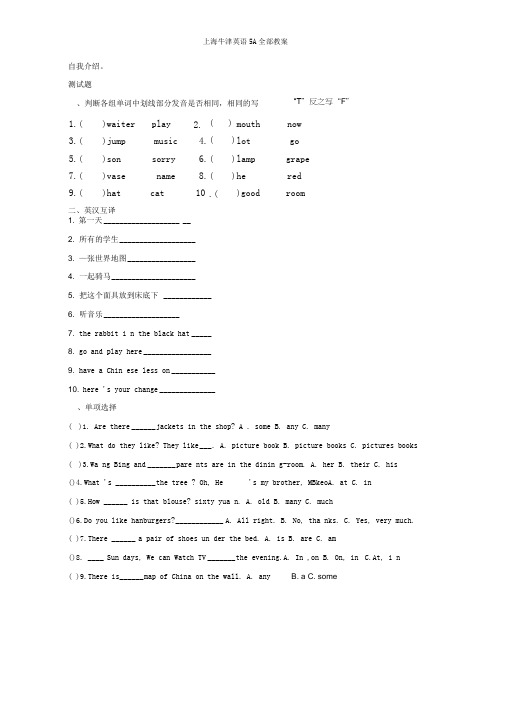
“T ”反之写“F ”B. aC. some自我介绍。
测试题1. 第一天 ___________________ __2. 所有的学生 ___________________3. —张世界地图 _________________4. 一起骑马 _____________________5. 把这个面具放到床底下 ____________6. 听音乐 ___________________7. the rabbit i n the black hat _____8. go and play here _________________9. have a Chin ese less on ___________ 10. here 's your change ______________ 、单项选择( )1. Are there ______ j ackets in the shop? A . some B. any C. many( )2.What do they like? They like ___ . A. picture book B. picture books C. pictures books ( )3.Wa ng Bing and _______ p are nts are in the dinin g-room. A. her B. their C. his ()4.What 's __________ t he tree ? Oh, He's my brother, MBkeoA. at C. in( )5.How ______ is that blouse? sixty yua n. A. old B. many C. much()6.Do you like hanburgers? ____________ A. All right. B. No, tha nks. C. Yes, very much. ( )7.There ______ a pair of shoes un der the bed. A. is B. are C. am()8. ____ Sun days, We can Watch TV _______ t he evening.A. In ,on B. On, in C.At, i n ( )9.There is______ m ap of China on the wall. A. any上海牛津英语5A 全部教案1.( )waiter play2. () mouth now 3.( )jump music 4. ( ) l ot go 5.( )son sorry 6. ( ) l amp grape 7.( )vase name 8.( ) h e red 9.()hatcat10 .()goodroom、判断各组单词中划线部分发音是否相同,相同的写二、英汉互译( )10 .I can see _ umbrella beh ind the door.It ()11. I ca n the violin . I likeA. play, playB. play, play ingC. play ing, play ( )12. ___ in your new school bag? There's__ yellow umbrella.A. a, an B. an, an C. an, a the violin .D. play ing, play ing're many books.'thand. She is writing.What are you writing, Mary? ” She asks. “ I 'm writing to my friend, RoseBut how can you? You don't know how to write.Says her sister.Well, ” says Mary, )1. Is Mary a schoolgirl?A. Yes, she is. B. No, she isn 'Ct.. We don 't know.)2. Who can read and write?A. Mary B. Rose C. JoanB. ThereC. The 'res a 'psenaccilr.ayon.A. What 'sB. What 'reC. Where 's( )13.Is there a park ___ your house? A. inB. onC. near( )14.Sometimes I watch TV in the afternoon,but my parent s___. A. not B. aren 't C. don 't ( )15. _____ c an ____ do? She can play the piano.A. What he B. What she C.What 's she 四、根据所给首字母提示,填入适当的单词完成下面的短文There i___a big supermarket n __ my home.Today is Sunday ,my parents and I are i __ the supermarket.We w _____ like to buy a big cake f ___ my grandpa 's birthday. 五、阅读短文,选择正确答案Mary is a little girl. She is only five years old. She is not at school. She doesn to read or write. But her sister Joan is a schoolgirl. She is ten. She knows how to read and write.One day, Joan sees her little sister in the room. She is at the table. There is a pencil in hermatter. Rose doesn 't know how to read, either.)3. What 's in Mary 's hand?A. There 's a pen. )4. What 's Mary doing?A. She 's drawing.B. She 's writing to her friend.C. She 's singing.( )5. Can Rose read and write?A. No, she can B. Yes, s'het. can. C. We don 't know. 六、阅读理解,判断正误(对的打 T ,错的打 F)This is a picture of our class. There are fifty Hive students in our class. You can see twenty-eight boys and twenty- seven girls. There is an American( 美国的 ) student in our class. His name is David. His English is very good. We all like him. He likes eating bread and cakes. He likes drinking milk and apple juice. We like eating rice and drinking tea. David can ski but we don are very happy together. ( )1. There are fifty -five boys in the class. ( ) 2. David is an English boy. () 3. David like bread and tea.( ) 4.Chinese students can ski. () 5 We all like David.七、根据所给中文写出句子1. 这儿有厕所么?对不起,我不知道,我不居住在这个城市。
《牛津小学英语5A》教案(通用6篇)

《牛津小学英语5A》教案(通用6篇)《牛津小学英语5A》篇1《牛津小学英语5a》第一单元第一教时教学目标:1. 复习巩固四年级所学知识。
2. 能掌握词汇first, second, third... building, day, all, happy, glad, again3. 能正确运用对话中的日常交际用语。
4. 初步理解和掌握课文第一段:it is the first day of the new term.all the students are back at school.they are happy to see each other again.教具准备:l 录音机和磁带l 课文挂图l 歌曲“two jackets”教学过程:1.listen and sing a song “two jackets”2.free talka. revision.b. greetings.welcome back to school.nice to meet you.(according to the real situation, the students practise )then moving to the sentence glad to see you. (students practise)2.presentation and practicet: what day is it today?s: it’s monday.t: what’s the date tod ay?it’s september 1st.it’s the first day of the new term.(new words: first, day, term)(amplify the structure of “the first ... of the…” )i’m happy. today all the students are back at school.glad to see you.we are happy to see each other again.(new words: all, back, back at school, glad, again, each other) (read and practice them, eg: read, make phrases, etc.)(according to the situation, let the students understand the meaning of the key sentences.)3.look at the picture of the text and answer the questions. (making clear the background)4.a. read and say (paragraph 1)1) listen to the tape2) read after the tape3) read by together5.look at picture 2 , review “there is...”t: there is a new building in the picture.(new word: building)t: how many floors are there in this building?s: four.(new word: floor)learn the name of “the ground floor/the first floor/ the second floor...”t: what’s the name of the rooms in this building? we will learn them next class.6.homework1) talk about our school2) copy the new words3) some translations第二教时教学目标:1. 复习四年级相关知识 a computer room, a music room, a tape recorder, a desk, a chair等。
《牛津小学英语5A》教案推荐六篇
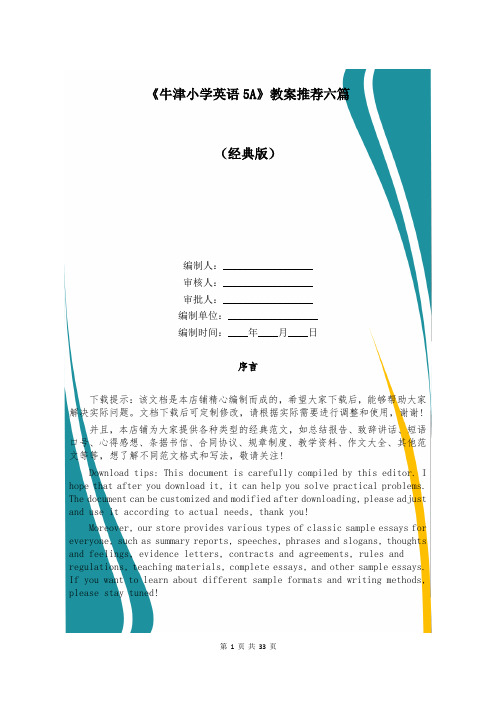
《牛津小学英语5A》教案推荐六篇(经典版)编制人:__________________审核人:__________________审批人:__________________编制单位:__________________编制时间:____年____月____日序言下载提示:该文档是本店铺精心编制而成的,希望大家下载后,能够帮助大家解决实际问题。
文档下载后可定制修改,请根据实际需要进行调整和使用,谢谢!并且,本店铺为大家提供各种类型的经典范文,如总结报告、致辞讲话、短语口号、心得感想、条据书信、合同协议、规章制度、教学资料、作文大全、其他范文等等,想了解不同范文格式和写法,敬请关注!Download tips: This document is carefully compiled by this editor. I hope that after you download it, it can help you solve practical problems. The document can be customized and modified after downloading, please adjust and use it according to actual needs, thank you!Moreover, our store provides various types of classic sample essays for everyone, such as summary reports, speeches, phrases and slogans, thoughts and feelings, evidence letters, contracts and agreements, rules and regulations, teaching materials, complete essays, and other sample essays. If you want to learn about different sample formats and writing methods, please stay tuned!《牛津小学英语5A》教案推荐六篇《牛津小学英语5A》教案篇1课题unit 3 at a music lesson第二课时(新授课)课时教学目标1、认知:(1)能听说读写词汇a lesson, learn。
上海全部整合版本牛津英语5A备课教案

1. To teach: the first of …
To elicit: What’s the date today?
(1) Show the phrase
the first of September
(2) Show more dates.
(3) Introduce three festivals.
Introduce <Harry Potter>
(1) Show the new words.
(2) Show a movie.
1. To learn: the first of …
(1) Look and read.
(2) Look and say.
the first of …
(3) Try to say:
(3) Act out the short dialogue.
3. To learn: favourite
(1) Read the new word.
(2) Read the paragraph.
4. To learn: second
(1) Read the new word.
(2) Read the paragraph.
(4) Play a game.
2. To teach: party/begin/bring
Introduce Eddie’s birthday party.
(1) Show the new words.
(2) Read the paragraph.
(3) Show the short dialogue.
2. Listen to the tape and read after it.
牛津小学英语5A全册教案

1.分组竞赛:
学生看、听教师课前作好的课件。小组比赛,用Is there /Are there…?There's/Therse are…How many…are there?进行小组竞赛,比一比哪一组能说出最多对话。教师在竞赛后表扬积极参与的学生。
2.练习册听力
四、Assign homework
4.正确的听、说、读、写句型Is there a…? Yes, there is. / No, there isn't. Are there any…? Yes, there are? / No, there aren't. How many…are there? There are…
5.能正确地运用对话中的日常交际用语和三会句型It is the first day of…They are happy to each other. Glad to see you. I'm not sure. It's / They're on the…floor.
2. T:Is there a noticeboard in our classroom?Are there any computers in our classroom.Is there a bookcase? How many…are there?
3.用Is/Are there…in our school? How many.. are there? Where is it? are they?对学生所做的本校-专用教室的调查结果进行检查,完成下表。
floor.
3.能正确的听、说、读词汇first, a term, back. each other. glad.
沪教版最新版本牛津英语5A教(学)案pdfppt

课堂氛围良好, 学生参与度高
教学评价客观、 公正,反馈及时、 有效
课程整体效果评估
学生参与度:评估学生在课堂上 的参与情况,判断是否能够积极 参与到课堂活动中。
学生反馈:通过课后与学生的交 流,了解他们对本节课的评价和 反馈,判断教学实施的效果。
添加标题
添加标题
添加标题
添加标题
课堂氛围:观察课堂氛围是否活 跃,学生是否能够以积极的态度 参与到课堂活动中。
02
教学内容安排
教学内容及步骤
教学内容:介绍沪教版最新版本牛津英语5A教材的教学内容及特点 教学步骤:介绍沪教版最新版本牛津英语5A教材的教学方法和流程 教材分析:对沪教版最新版本牛津英语5A教材进行深入的分析和解读 课程设置:介绍沪教版最新版本牛津英语5A教材的课程设置和安排
教学方法和手段
情景教学
学情分析
学生年龄段为XX-XX岁 学生在学习中存在的问题和困惑 学生的学习风格和兴趣点 学生的认知水平和能力水平
教学目标和重难点
教学目标:培养学生听说读写能 力,提高英语综合素养
教学难点:运用所学知识进行实 际交流与表达
添加标题
添加标题
添加标题
添加标题
教学重点:掌握重点词汇、句型 和语法知识
针对不同层次学生制定不同教学 目标,因材施教
教学辅助工具的选择与应用
教辅工具的种类: PPT、PDF、图片、 视频等
选择依据:根据 教学内容、学生 特点、教师需求 等因素综合考虑
应用方法:利用 教辅工具进行辅 助教学,如演示 、讲解、互动等
注意事项:避免 过度依赖教辅工 具,要结合自身 教学风格和方法 。
06
教学实施效果评估
学生学习效果评估
牛津小学英语5a教案

牛津小学英语5A教案一、教学目标通过本节课的学习,学生能够: - 掌握英语单词和短语的发音和拼写; - 能够运用目标语言进行简单的对话,并正确使用句型; - 意识到学习英语的重要性,并主动参与到课堂活动中。
二、教学准备•教材:牛津小学英语5A教材•多媒体设备:投影仪、音响等•教学辅助工具:图片、卡片、单词卡片等三、教学过程1. 导入新课(5分钟)在教室的黑板上展示本课的主题图片,并引导学生观察图片,用英语描述图片中的内容,激发学生的学习兴趣。
然后通过问题的提问方式,引导学生猜测本节课的主题。
2. 新课讲解(15分钟)通过多媒体展示教材中相关的图片和短语,并辅以手势和肢体语言的示范,引导学生学习新课的内容。
同时,利用黑板或白板,将重点单词和短语写在上面,让学生跟读,巩固记忆。
3. 听力训练(20分钟)播放录音,让学生听录音,并在听录音的过程中完成相关的听力练习,例如根据听力内容选择正确的图片或回答问题。
接着,教师与学生进行听力对话,引导学生正确理解听力内容,并提高学生对听力的理解和反应速度。
4. 语言操练(20分钟)教师设计一系列语言操练活动,例如短语匹配、句子填空等,让学生运用所学的语言进行对话和操练,培养学生的口语表达能力。
同时,教师可分组让学生之间进行对话练习,增加学生的合作和交流能力。
5. 扩展活动(15分钟)通过图片或视频展示,引导学生进行扩展活动,例如讨论与本节课话题相关的话题,开展小组活动,让学生在轻松、愉快的环境中运用所学语言,扩展学生的思维和表达能力。
6. 作业布置(5分钟)布置与本节课内容相关的作业,例如课后练习册上的练习题、口头作业等,加深学生对本节课内容的理解和记忆。
四、教学反思本节课的教学目标主要是让学生掌握新课的单词和短语,能够运用所学语言进行简单的对话。
通过多种教学手段,例如听力训练和语言操练等,提高学生的听说能力。
同时,通过扩展活动,引导学生参与互动,培养学生的合作与交流能力。
上海版五年级英语上册(沪教牛津5A)全册教案

按住Ctrl键单击鼠标打开配套名师教学讲课视频播放上海沪教版牛津小学英语5A(5-8单元)The First Period一、教学内容:复习第一单元,完成本单元A部分内容。
二、教学目标:1.通过复习,学生进一步掌握第一单元的四会单词和句型。
2.通过复习,学生能灵活使用第一单元日常交际用语。
3.完成本单元A部分内容。
三、教学重、难点:通过复习,学生进一步掌握第一单元的四会单词和句型。
通过复习,学生能灵活使用第一单元日常交际用语。
四、课前准备:1.第一单元图片和挂图。
2.磁带和录音机。
3.本部分内容的投影片。
五、教学过程:Step 1 Warm up1.师生齐唱歌曲Two jackets。
2.Free talk。
Step 2 Revision教师出示第一单元会话挂图,创设情景,学生表演对话。
鼓励学生自由创作。
2.教师出示词汇卡片,师生问答复习第一单元词汇和句型:T:What can you see in the picture?S:I can see a building.T:Is there a reading room in the building?S:Yes,there is.(No,there isn’t.)T:Are there any computer rooms?S:Yes,there are.(No,there aren’t.)T:How many sports halls are there?S:There are four.(a toilet,a garden,a table tennis,a swing,a slide, a see-saw的方法同上)3.教师引导学生运用所学词汇和句型,根据实际情况自由交际。
Step 3 Look,read and learn1.教师出示本部分内容的投影片,指导学生朗读句子。
2.要求学生根据图片及句子内容,把图片和句子配对,然后在图下的格子里填上相应句子的英文字母。
《牛津小学英语5A》教案

《牛津小学英语5A》教案一、教材分析《牛津小学英语 5A》是小学英语学习的重要阶段,教材内容丰富多样,涵盖了词汇、语法、听说读写等多个方面。
本教材注重培养学生的英语综合运用能力,通过生动有趣的情境和活动,激发学生的学习兴趣。
教材中的词汇包括了日常生活、学校、家庭、动物等常见主题,语法知识点则逐步加深,如一般现在时、现在进行时等的基本用法。
教材中的对话和短文贴近学生生活,有助于提高学生的阅读理解和口语表达能力。
二、学情分析五年级的学生已经有了一定的英语基础,具备了初步的听说读写能力。
他们对英语学习有较高的热情,好奇心强,喜欢参与各种英语活动。
然而,部分学生在语法的理解和运用上可能还存在困难,需要更多的练习和指导。
三、教学目标1、知识目标学生能够掌握教材中的重点词汇和句型。
理解并正确运用所学的语法知识。
2、技能目标能够听懂、会说、认读教材中的对话和短文。
能够用英语进行简单的交流和表达。
3、情感目标培养学生学习英语的兴趣和积极性。
增强学生的自信心,敢于用英语表达自己的想法。
四、教学重难点1、教学重点重点词汇的记忆和运用。
关键句型的理解和操练。
语法知识点的掌握和应用。
2、教学难点复杂句型的结构和用法。
语法知识在实际语境中的灵活运用。
五、教学方法1、情景教学法通过创设生动的情境,让学生在实际情境中学习和运用英语。
设计有趣的游戏活动,激发学生的学习兴趣,巩固所学知识。
3、任务驱动法布置明确的任务,让学生在完成任务的过程中提高英语能力。
六、教学过程1、导入通过播放一段与本单元主题相关的英语歌曲或动画,引起学生的兴趣,导入新课。
2、词汇教学利用图片、实物、动作等多种方式呈现新词汇,帮助学生理解词义。
带领学生跟读、拼写词汇,进行多次重复练习。
3、句型教学结合情境,讲解重点句型的结构和用法。
让学生进行模仿操练,通过替换关键词等方式进行句型练习。
4、对话教学播放对话录音,让学生整体感知对话内容。
逐句讲解对话,帮助学生理解。
牛津小学英语5a教案

牛津小学英语5a教案教案标题:牛津小学英语5A教案教学目标:1. 通过本节课的学习,学生将能够掌握并正确运用本课时的词汇和句型。
2. 培养学生的听、说、读、写的综合语言能力。
3. 培养学生的合作意识和团队合作能力。
教学重点:1. 学习并掌握本课时的词汇和句型。
2. 培养学生的听力和口语表达能力。
教学准备:1. 牛津小学英语5A教材和课件。
2. 单词卡片和图片。
3. 录音机和录音材料。
教学过程:Step 1: Warm-up (5分钟)1. 教师与学生进行简单的问候和打招呼。
2. 通过播放一段英文歌曲或唱一首英文儿歌来热身。
Step 2: Presentation (10分钟)1. 教师呈现本课时的新词汇和句型,并通过图片或实物进行示范和解释。
2. 教师与学生一起进行词汇和句型的操练,确保学生理解并能正确运用。
Step 3: Listening (15分钟)1. 教师播放录音材料,要求学生仔细听,并根据听到的内容回答问题。
2. 教师再次播放录音材料,要求学生跟读并模仿录音中的语音语调。
Step 4: Speaking (15分钟)1. 教师分组让学生进行小组讨论,讨论关于本课时主题的问题。
2. 教师鼓励学生积极参与讨论,并提供必要的帮助和指导。
Step 5: Reading (10分钟)1. 教师布置阅读任务,让学生阅读与本课时主题相关的短文或对话。
2. 学生独立阅读,并回答相关问题。
Step 6: Writing (15分钟)1. 教师要求学生根据所学内容,完成一篇关于本课时主题的短文或写一篇简短的日记。
2. 学生完成写作任务后,可以相互交流并互相修改。
Step 7: Consolidation (5分钟)1. 教师复习本课时的重点内容,让学生回顾所学的词汇和句型。
2. 教师提供一些练习题,检查学生对所学内容的掌握情况。
Step 8: Homework (5分钟)1. 教师布置适当的作业,如复习所学内容、完成练习题或写一篇关于本课时主题的作文。
牛津小学英语5A教案(全册)
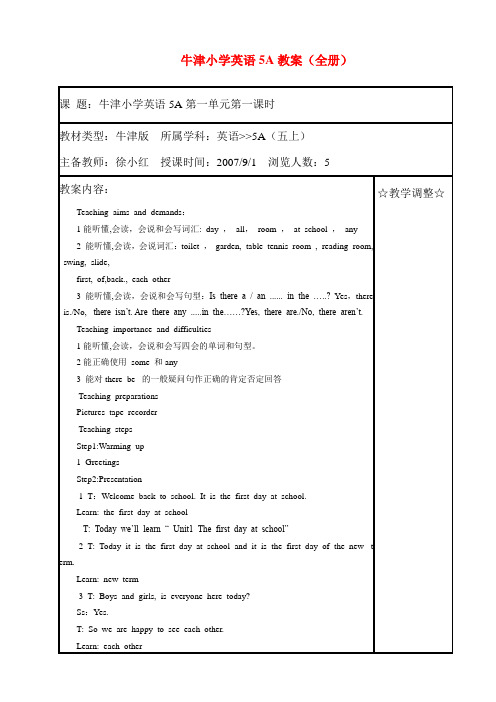
(5)Read together.
Step4 Consolidation.
1.看图,用自己的话介绍图。
2. Talk about your school .
3.划词组。
Step 5 Homework.
1. Copy the phrase.
2.熟读课文。
Teaching importance and difficulties
1能听懂,会读,会说和会写四会的单词和句型。
2能正确使用some和any
3能对there be的一般疑问句作正确的肯定否定回答
Teaching preparations
Pictures tape recorder
Teaching steps
T: Yes, there’re two.
教学How many … are there? There are ….
T:How many classrooms are there in our school?
S: There are …
Working in pairs.
5. T: Are there any reading rooms in our school?
单词辨音
1 plate name fat late
2 game family make tape
3 cat plane cake grape
Step6 Assign homework
1回家默写本课重点句型。
2完成三级训练中的A卷笔试部分1,2题。
☆教学调整☆
教学反思:
课题:牛津小学英语5A第1单元第四课时
S: Yes, there are.
上海牛津英语5a教案
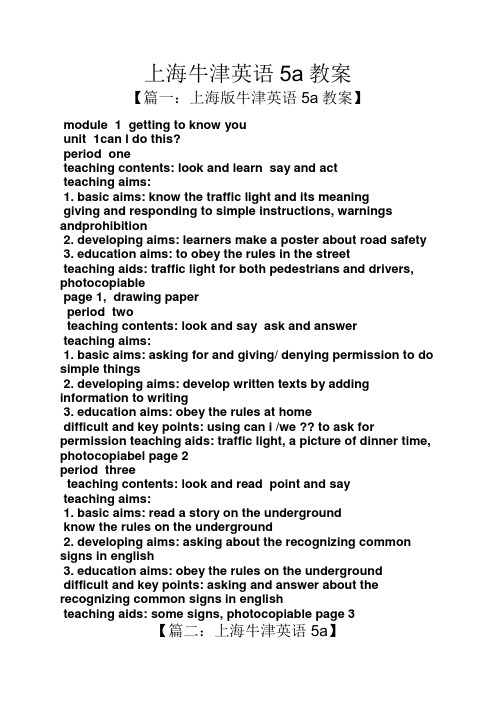
上海牛津英语5a教案【篇一:上海版牛津英语5a教案】module 1 getting to know youunit 1can l do this?period oneteaching contents: look and learn say and actteaching aims:1. basic aims: know the traffic light and its meaninggiving and responding to simple instructions, warnings andprohibition2. developing aims: learners make a poster about road safety3. education aims: to obey the rules in the streetteaching aids: traffic light for both pedestrians and drivers, photocopiablepage 1, drawing paperperiod twoteaching contents: look and say ask and answerteaching aims:1. basic aims: asking for and giving/ denying permission to do simple things2. developing aims: develop written texts by adding information to writing3. education aims: obey the rules at homedifficult and key points: using can i /we ?? to ask for permission teaching aids: traffic light, a picture of dinner time, photocopiabel page 2period threeteaching contents: look and read point and sayteaching aims:1. basic aims: read a story on the undergroundknow the rules on the underground2. developing aims: asking about the recognizing common signs in english3. education aims: obey the rules on the undergrounddifficult and key points: asking and answer about the recognizing common signs in englishteaching aids: some signs, photocopiable page 3【篇二:上海牛津英语5a】【篇三:沪教版最新版本牛津英语5a教案】 5a module 1 getting to know you。
- 1、下载文档前请自行甄别文档内容的完整性,平台不提供额外的编辑、内容补充、找答案等附加服务。
- 2、"仅部分预览"的文档,不可在线预览部分如存在完整性等问题,可反馈申请退款(可完整预览的文档不适用该条件!)。
- 3、如文档侵犯您的权益,请联系客服反馈,我们会尽快为您处理(人工客服工作时间:9:00-18:30)。
自我介绍。
测试题一、判断各组单词中划线部分发音是否相同,相同的写“T”,反之写“F”1.()waiter play2.()mouth now3.()jump music4.()lot go5.()son sorry6.()lamp grape7.()vase name 8.()he red9.()hat cat 10.()good room二、英汉互译1. 第一天_________________ __2. 所有的学生_________________3.一世界地图________________4. 一起骑马 __________________5. 把这个面具放到床底下__________6. 听音乐__________________7. the rabbit in the black hat__________8. go and play here__________________9. have a Chinese lesson ______________10. here’s your change____________三、单项选择( )1. Are there _______ jackets in the shop? A . some B. any C. many ( )2.What do they like? They like _____. A. picture book B. picture books C. pictures books( )3.Wang Bing and _______ parents are in the dining-room. A. her B. their C. his( )4.What’s ______ the tree ? Oh, He’s my brother, Mike.A. at B. on C. in ( )5.How______ is that blouse? sixty yuan. A. old B. many C. much( )6.Do you like hanburgers?_________ __ A. All right. B. No, thanks. C. Yes, very much.( )7.There ______ a pair of shoes under the bed. A. is B. are C. am( )8.____ Sundays, We can Watch TV ______ the evening.A. In ,on B. On, in C.At, in( )9.There is______ map of China on the wall. A. any B. a C. some( )10.I can see _ umbrella behind the door.It ’s__ yellow umbrella.A. a, an B. an,an C. an, a( ) 11. I can the violin . I like the violin .A. play, playB. play, playingC. playing, playD. playing, playing( )12.____ in your new school bag? There ’re many books.A. What ’sB. What ’reC. Where ’s( )13.Is there a park ______ your house? A. in B. on C. near( )14.Sometimes I watch TV in the afternoon,but my parents___. A. not B. aren ’t C. don ’t( )15._____ can _____ do? She can play the piano.A. What he B. What she C.What ’s she四、根据所给首字母提示,填入适当的单词完成下面的短文There i___a big supermarket n_____my home.Today is Sunday ,my parents and I arei____ the supermarket.We w_____like to buy a big cake f_____my grandpa ’s birthday.五、阅读短文,选择正确答案Mary is a little girl. She is only five years old. She is not at school. Shedoesn ’t know how to read or write. But her sister Joan is a schoolgirl. She is ten.She knows how to read and write.One day, Joan sees her little sister in the room. She is at the table. Thereis a pencil in her hand. She is writing. “What are you writing, Mary?” She asks.“I ’m writing to my friend, Rose.” “But how can you? You don ’t know how to write.” Says her sister. “Well,” says Mary, “It doesn ’t matter. Rose doesn ’t know how to read, either.” ( )1. Is Mary a schoolgirl?A. Yes, she is. B. No, she isn ’t. C. We don ’t know.( )2. Who can read and write?A. Mary B. Rose C. Joan( )3. What ’s in Mary ’s hand?A. There ’s a pen. B. There ’s a pencil. C. There ’s a crayon.( )4. What ’s Mary doing?A. She ’s drawing.B. She ’s writing to her friend.C. She ’s singing.( )5. Can Rose read and write?A. No, she can ’t. B. Yes, she can. C. We don ’t know.六、阅读理解,判断正误(对的打T ,错的打F )教学 过This is a picture of our class. There are fifty–five students in our class. You can see twenty-eight boys and twenty- seven girls. There is an American(美国的) student in our class. His name is David. His English is very good. We all like him. He likes eating bread and cakes. He likes drinking milk and apple juice. We like eating rice and drinking tea. David can ski but we don’t.We are very happy together. ( ) 1. There are fifty – five boys in the class.( ) 2. David is an English boy.( ) 3. David like bread and tea.( ) 4.Chinese students can ski.( ) 5 We all like David.七、根据所给中文写出句子1. 这儿有厕所么?对不起,我不知道,我不居住在这个城市。
Is there a ______?______,I _____ know. I don’t _____ _____ the city(城市)2. 你们班有多少男生?27个,他们会打篮球么?会,所有男生都会。
--______ ____ _____ _____ boys are there in your class?--Twenty-seven. _____ they play basketball? ______ ,______the boys can play basketball。
U1.Water1.Words and Expressions.first第一,首先 next下一步,接下来then然后 finally最后 in the kitchien在厨房make tea泡茶would like =want 想要 boil 煮,烧 boil the water烧水What’s next?接下来呢/下一步呢?put……in……把……放进……eg:put the apples in the box.pour……into……把……倒进……,pour倒Pour the juice into the glass.teapot茶壶 It tastes great/good.尝起来很棒。
Yangtze River长江, start开始 mountain高山in the east/west/south/north of China在中国东/西/南/北部run down从……流下through(从部)穿过Yangtzs River runs through the beautiful Three Gorges.cross(从表面)穿过let’s cross the street.part of 一部分 run into流入water drop水滴 raindrop雨滴 fall from从……落下go up上升 get变得 rise up升起,升高fly over飞过,飞越 fall down to the groud掉落到地上thirsty渴 drink喝 be inside在……里面U2.Windblow吹,刮 grently轻轻地 happily高兴地heavily剧烈地,猛烈地 heavy猛烈的hope希望 be made of由……做成strongly强有力地,猛烈地 wind-bell风铃windmill风车 fly a kite放风筝 sometimes有时move slowly慢慢转动 move quickly快速转动go out出去 be afraid恐怕It rains heavily下大雨 heavy rain大雨strong wind大风 weather天气watch TV看电视 tomorrow明天 go to the park去公园play footall踢足球 the sound of the wind风的声音make a wind-bell/windmill做个风铃/ 风车 hear听到Phonetic Alphabet reviewing M1-M2.e, e_e, ee ,ea字母组合一般读/i:/eg:she,he,me, Chinese ,these, bee,sweet sea read i,y读/i/的单词eg:it,this,drill, easy,very,happy,earlye,a,ea读/e/eg:bed,pet any,many head,breada读/æ/eg:dad,back,apple,blackp读/p/ b读/b/eg:pick,map eg:book,jobt读/t/ d读/d/eg:taste,fruit eg:date,badk,c,ck读/k/eg:kite,work cook,picnic, clock,duckg读/g/eg:game,biga,ar读/ɑ:/eg:class,past,ask,bath, arm,park,sharp,largeu,o 读/ʌ/eg:us,club,duck,puzzle other,son,love,colouru,oo 读/u:/eg:rule, too,school,room,toothu,oo 读/ʊeg:sugar,full,put,pull book,look,cook,footf 读/f/ v 读/v/eg:food,roof eg:van,liveth 读/θ/ th 读/ð/eg:think,tooth eg:that,with判断各组单词中划线部分发音是否相同,相同的写“T ”,反之写“F ”1.( )she pet2. ( )these Japanese3.( )bee see4. ( )sea head5.( )it fish6. ( )easy fly7.( )andy dad 8. ( )apple black9. ( )bread read 10. ( )black back11.( )waiter play 12.( )mouth now13.( )jump music 14.( )lot go15.( )son sorry 16.( )lamp grape17.( )vase name 18.( )he red19.( )hat cat 20.( )good room选择题 ( )1. Nancy can_______. A. swim B. swimming C. swims ( )2.--What can you _______ ? --I can ______ . A. do; skiing B. doing; ski C. do; ski ( )3. I can play _____football, but I can ’t play____guitar.A. the;/B. /;theC. the;the( )4. -- ______behind the tree? --There ’s a cat.A. Where ’sB. What ’sC. Whose( )5. Don ’t look at the window, listen ________ me, please.A .to B. at C. /( )6. Shall we play games __________ our friendsA .with B. and C. to( )7. I want to some cakes and a cup of milk .A .make B. drink C. have( )8. Here a lot of pictures for you.A. isB. amC. are( )9. I would like ________, and I would like _______ some flowers for 教学 过my parents.A. a vase; buyB. some vases; buyingC. a vase; to buy( ) 10.I can______the violin. I like_____the violin.A .play, playing B. play, play C .playing, playing1.复习现在进行时结构:be+v.ing表示正在进行的动作,常与now(现在),listen(听),look (看)等词连用Eg:I am eating a cake now.我现在在吃蛋糕Look!They are singing.听!他们在唱歌v.的现在分词变换规则(1)一般加ingEg:look-looking read-reading(2)以不发音的字母e结尾的单词,去e加ingEg:make-making take-taking(3)以重读闭音节结尾,即最后一个音节中只有一个元音字母其后紧跟一个辅音字母的音节,双写最后一个辅音字母+ing(4)以ie结尾的单词改ie为y加ingEg:lie-lying die-dying音标s,c读/s/ 注:c在i和e前读/s/eg:sign,bus city,nicez,s读/z/eg:zoo,size visit,ists读/ts/eg:lights,parts,boats,rabbitsdz读/dz/eg:cards,clouds,hands,bedsor,al,ou,oor字母组合读/ɔ:/eg:short,horse hall,fall autumn,naughtydoor,flooro,a读/ɔ/eg:office,box,off,wrong what,want,watcher,ir,ur,or字母组合读/ə: /eg:her,term bird,third nurse,turnwork,worder,a读/ə /eg:teacher,paper,driver,farmerpanda,banana,again,along2.课文重点:1.Words and expressionfirefighter n.消防员 safety n.安全forest n.森林 be careful小心poster n.海报 look at看about prep.关于 mustn’t禁止match n.火柴 smoke v.抽烟near prep.靠近 campfire n.营火, 篝火play with matches 玩火柴 start campfires 生篝火 What mustn’t we do?我们禁止做什么?We mustn’t ……………我们禁止……burn v.燃烧 luckily adv.幸运地hurt adj.受伤的 county park 国家公园everywhere adv.到处 helicopter n.直升机fight v.战斗 bravely adv.勇敢地soon adv.不久,很快 die down熄灭sign n.牌子 the Stone Age 石器时代cave n.山洞 heat n.热,热量 light n.光give+某人+某物给某人某物eg:Give me a book,please.请给我一本书always adv.总是,一直 raw adj.生的,未熟的raw meat 生肉 hate v.讨厌,不喜欢not ……at all 一点也不throw +某物+away 扔掉某物 into prep.……里面smell link.闻起来…… smell+adj.cook v.做饭,烧菜 quickly adv.迅速地,快速地 go outside出去 never从不,绝不 lift n.电梯 dangerous adj.危险的 inside prep.……里面smoky adj.多烟的, 冒烟的 cover v.掩盖,盖住 crawl v.爬行 crawl out爬出去 fast adv.迅速地2.理解书中容,认识各种防火标志3.用自己的话说说,发生火灾时应该怎么样逃生。
